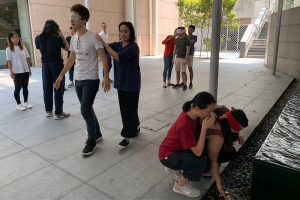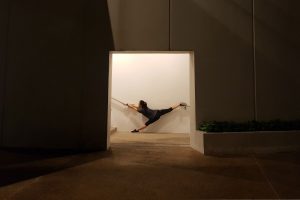February 03, 2020
Through the arts, new ideas and new approaches to problems can be revealed. In an educational context, we frequently talk about artists (both student and professional) who work with faculty within NUS to develop works that explore different approaches to art making. However, this process works both ways as artists, too, bring insight and perspective to even the most experienced of thought leaders.
Students from the School of Design and Environment have recently partnered with NUS Dance Synergy in the development of a new site-specific work. This partnership is being facilitated by NUS Department of Architecture’s Dr Zdravko Trivic, as well as the Artistic Director of NUS Dance Synergy, Yarra Ileto. We caught up with Dr Trivic to better understand how he is tapping on dance and the members of NUS Dance Synergy to work with his students to see the world in a different way.
Architecture is a blend of engineering and design, yet an understanding of people and how they interact with their environment is also critical. What do dancers bring to your student’s understanding that others may not?
Multi-sensory experiences (engaging all senses) and emotional and symbolic relationships with spaces are central to our understanding, use and appreciation of the built environment. Yet, despite the immense potential of architecture to engage the immediacy of our bodily, emotional and intellectual site-specific experiences, arguably more fully and effectively than other art forms, our contemporary cities are often either sensory overwhelming or sensory depleting.
While sensory embodied experience is certainly not a new topic in architectural and urban design discourses, the design practices have historically tended to privilege vision over other senses, while neglecting the full capacity of holistic sensory experiences.
For the past three years, through an elective module ‘City and Senses’, my key goal was to break with the typical approach to space analysis and design, based on functionality and efficiency, and to challenge the limits of architecture and urban design students so they venture beyond their comfort zone and explore new unconventional ways of enriching and uplifting urban experience and design, using all senses. This involves focusing on conditions, situations, phenomena and ambiances that result from, engage and challenge the subjective embodied experience.

Partnering with Yarra Ileto and NUS Dance Synergy created opportunities for new forms of collaborative spatial investigations, engagement and co-creation, while re-reading, re-exploring and re-designing the familiar public spaces through bodily movement and interaction, together. While bodily exploration may seem so natural to the dancers, it considerably challenges the ways architecture students approach to space analysis and design. Dancing also requires full bodily (and inter-bodily) coordination and adaptability to unexpected situations, which are some of the critical skills architectural students learnt through this collaboration.
Is this your first time working with artists to facilitate a teaching experience? What has surprised you about the process?
For a long time, I have been intrigued by the relationship between body, space and arts, and the impressive works by Olafur Eliasson, (e.g., ’The Weather Project’, 2003), SUPERFLEX (e.g., ‘One Two Three Swing’, 2017), Georges Rousse (‘Geometric Art’, 2014), and Fujiko Nakaya (e.g., ‘Fog Sculptures‘, 2017), among other artworks inspired by challenging human perception, embodied experience and (micro-)climate conditions.

In my view, the arts have always been one of the most fertile platforms for innovative body-space-mind exploration and experimentation, which is not always possible in a rather rigid architectural design realm. The collaboration with NUS Centre For the Arts and NUS Dance Synergy provided an unconventional and interdisciplinary platform for diverse knowledge and skills exchange and mutual re-investigation of the complexities of body, space and arts relationships and the role of arts in creative place-making.
In my teaching and research experience, I have previously collaborated with anthropologists, ethnographers and social scientists who brought the necessary interdisciplinary aspect to my work. While I worked with local artists in one of my research projects through NAC (‘Arts and Culture Nodes in the Heartlands of Singapore’), this was the first time I have actively engaged artists in my teaching process.
The key means of collaboration were two introductory sensory workshops (‘Sensing the Site’, and “Mindful Spatial Experiencing”(MSE), conducted by an architect and dancer Ms Anja Humljan) and three sharing sessions joined by both architecture and dance students. Despite the differences and limited number of contact sessions, I was genuinely surprised about the extent to which bodily engagement was successful as a universal language that broke the barriers between the disciplines, provided fruitful means of mutual learning and exchange, and challenged the typical client-designer relationship.
Translating gathered sensory information into meaningful design was the biggest challenge for the architecture students, yet understanding the dancers’ point of view and spatial behaviour, as well as participating in dancers’ exercises, gradually developed into different ways of synthesising sensory and activity rhythms of the site and the visions for the site-specific performance.
How will you know if this partnership has been successful? Are their criteria you’re hoping the dancers and Architecture students will meet, or is there some other form of evaluation?
It is rather challenging to “measure” the success of any project or collaboration, especially when such partnerships have been established for the first time and are still ongoing. In my view, the most invaluable and rewarding outcome was the dynamic dialogue created between the dancers and the architecture students about the ways artistic practices can inform urban design and co-design, and vice versa, how urban design and sensorial investigations can inform dance choreography and site-specific performance. Readiness to step into each other’s shoes not only challenged the comfort of both participating groups, but provided avenues for both
exploring and expressing creativity together. It is the participatory co-design and co-creation processes that I value more than the actual design/performance outcomes. Architecture students found this process slippery and at points stressful and frustrating, and, unsurprisingly, it took a while to fully embrace it.
Besides gaining skills in sensory documentation, (rhythm-)analysis and visualisation, the key learning objectives were to boost critical and creative, open-minded and inclusive thinking, and to engage and systematically dissect multiple subjectivities and perspectives into coherent design narratives.
Finally, students found the entire process novel and rewarding.
Would you approach this sort of collaboration differently if you were working with artists in another genre? Visual artists? Musicians? Theatre?
In both my teaching and research, I am continuously testing the capacities of the multi-sensory approach to architectural and urban design and its application to different issues and settings. Bodily explorations and sensory mapping exercises have so far proven to be a fertile and flexible means of spatial investigation and dialogue, regardless of participants’ backgrounds, while being sensitive to context-specific conditions. In that sense, I believe that the overall phenomenological approach employed this time with dancers would be applicable and beneficial for a range of art genres, yet probably with some adjustments to the actual techniques and instruments of engagement and analysis.
I like to keep my teaching approach explorative, flexible and customisable as much as possible in order to allow for two-way and continuous learning process. In that sense, every collaboration brings in its own specificities, and these are the most exciting to me, as they allow both the students and myself to learn and grow from each other both personally and professionally.

